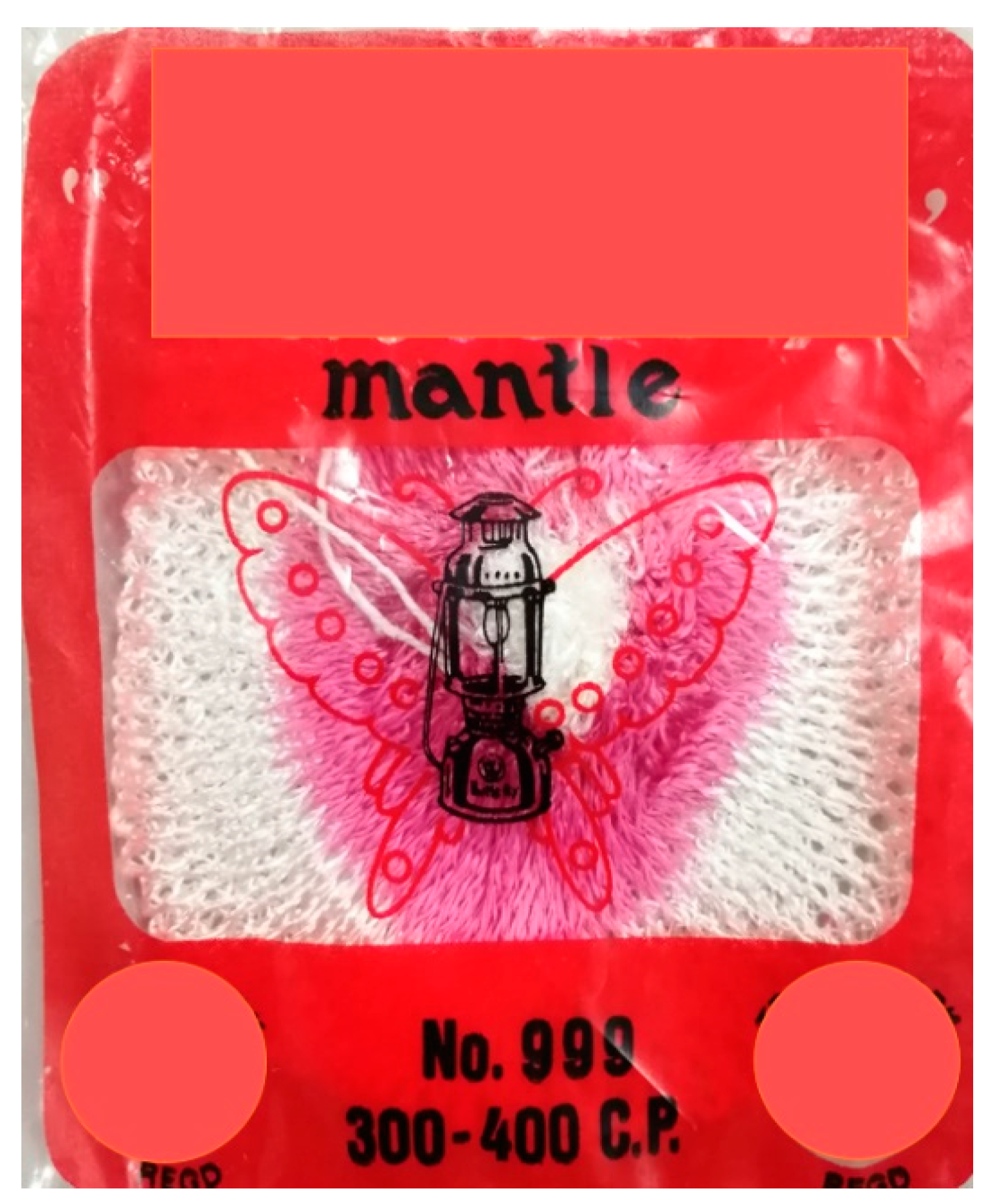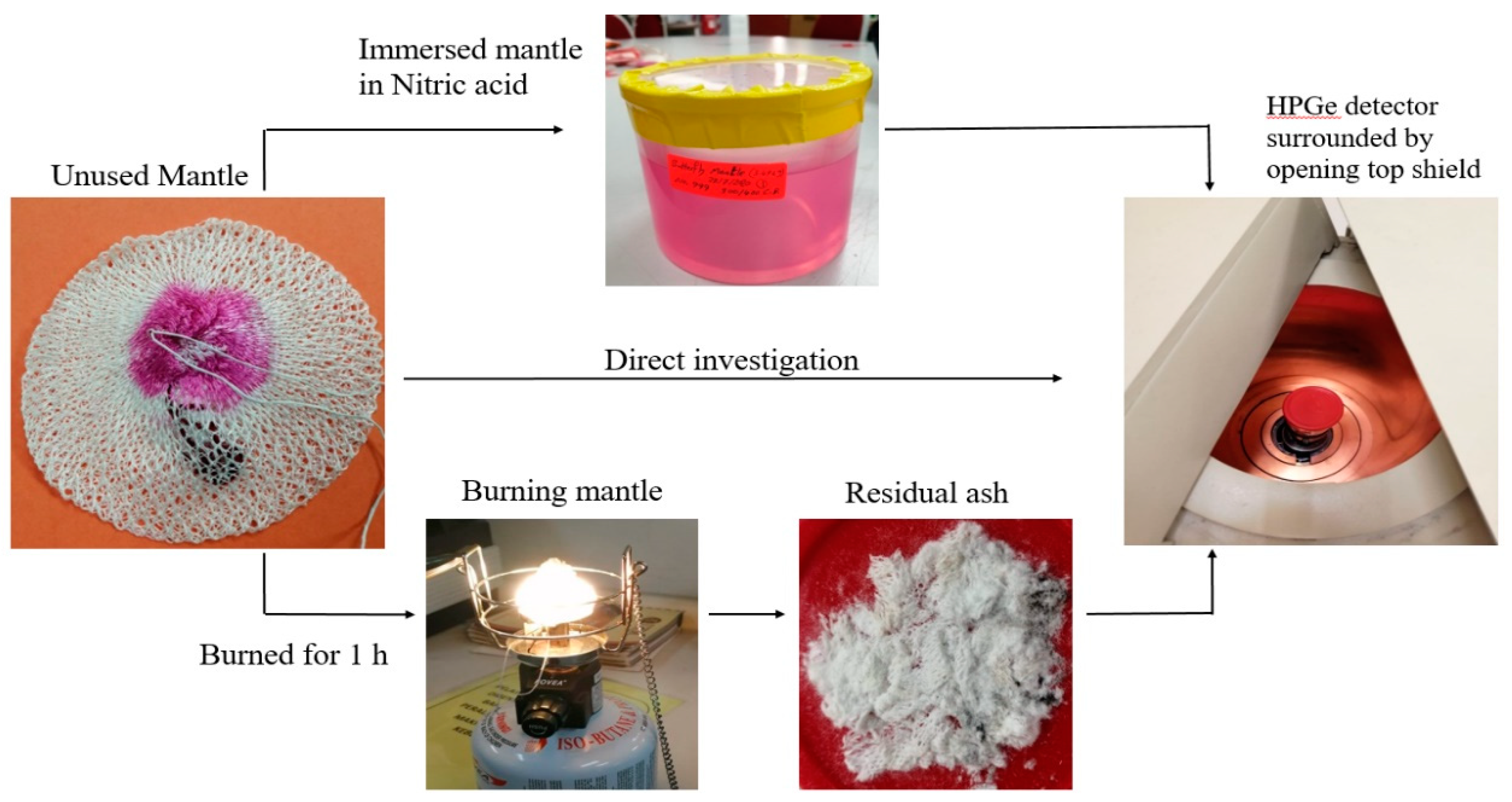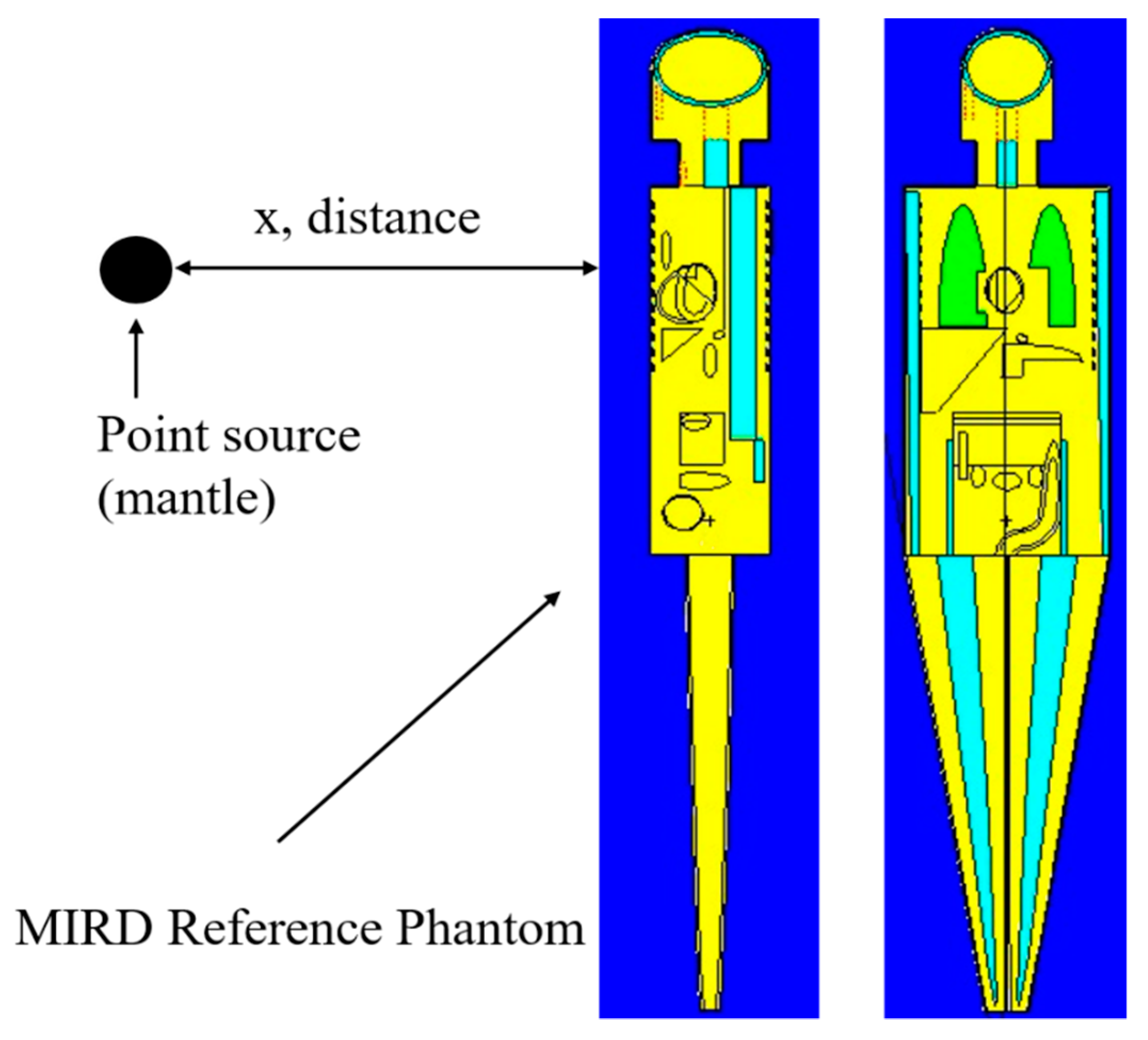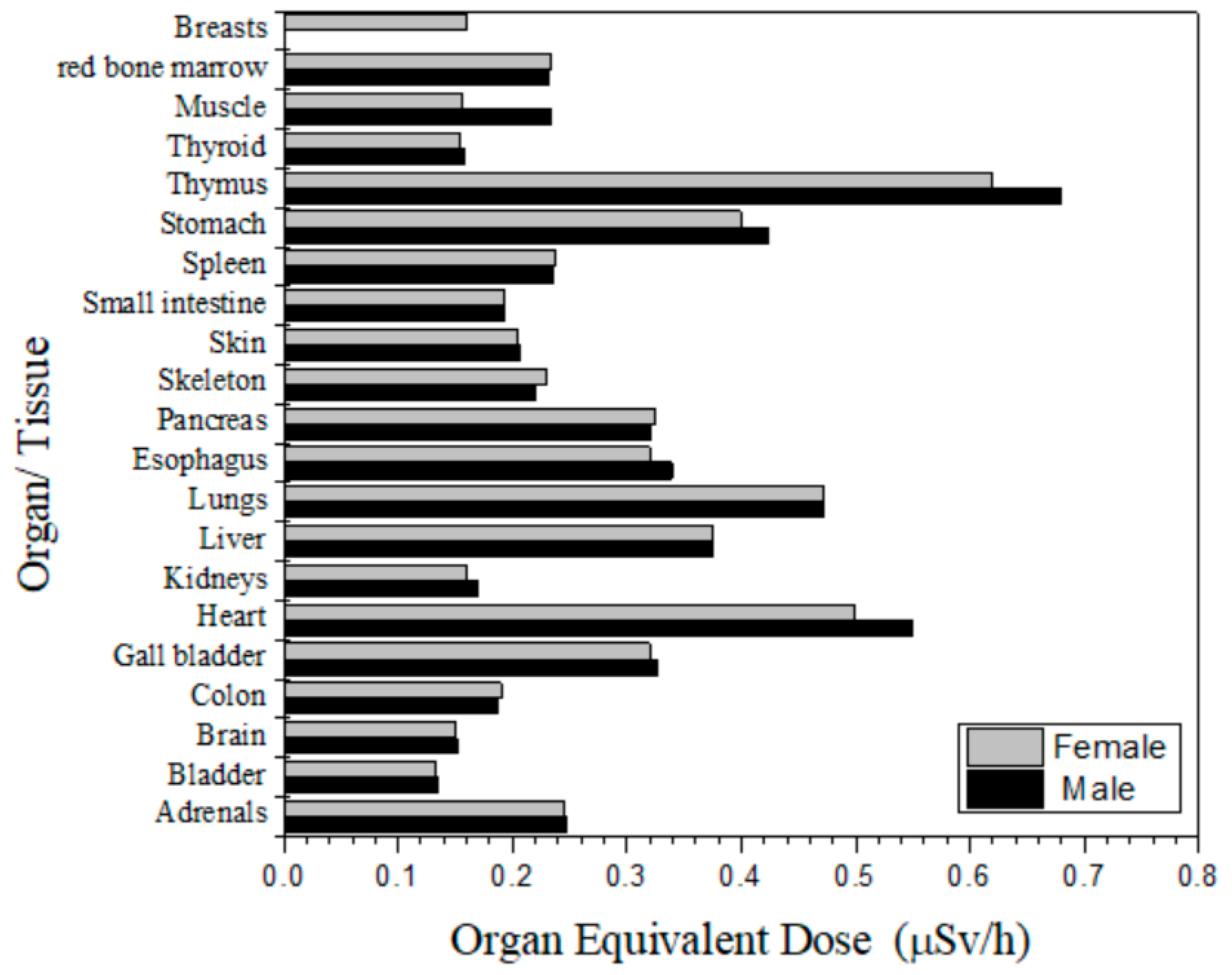The Radioactivity of Thorium Incandescent Gas Lantern Mantles
Abstract
1. Introduction
2. Materials and Methods
2.1. Sampling
2.2. Direct Measurement of Thorium Daughters, Using HPGe γ-Spectrometry
2.3. Mantles Immersed in HNO3 and Distilled Water
2.4. Burned Gas Lantern Mantle
2.5. Characterization of Gas Lantern Mantle
2.6. Monte Carlo (MC) Simulation and Evaluation of Effective Dose (ED)
3. Results and Discussion
3.1. Measurements of 232Th Activity in Gas Mantle
3.2. Build up Daughter Nuclides
3.3. Thorium Concentration in Gas Mantle
3.4. Organ Equivalent and Effective Doses
4. Conclusions
Author Contributions
Funding
Conflicts of Interest
References
- Regulatory Commission. Final Programmatic Environmental Impact Statement Related to Decontamination and Disposal of Radioactive Wastes Resulting from March 28, 1979, Accident, Three Mile Island Nuclear Station, Unit 2: Docket No. 50-320, Metropolitan Edison Company, Jersey Central Power and Light Company, Pennsylvania Electric Company; Nuclear Regulatory Commission: Washington, DC, USA, 1980; Volume 88, NUREG-0683. [Google Scholar]
- Brits, R.J. Measurement of Th content of gas mantles. Health Phys. 1985, 48, 124. [Google Scholar] [PubMed]
- Nuclear Regulatory Commission. Systematic Radiological Assessment of Exemptions for Source and Byproduct Materials. In (NUREG-1717) NUREG Report; Nuclear Regulatory Commission: Washington, DC, USA, 2001. [Google Scholar]
- Mohammadi, H.; Mehdizadeh, S. Re-identification of/sup 232/Th content and relative radioactivity measurements in a number of imported gas mantles. Health Phys. 1983, 44, 649–653. [Google Scholar] [PubMed]
- Luetzelschwab, J.W.; Googins, S.W. Radioactivity Released from Burning Gas Lantern Mantles. Health Phys. 1984, 46, 873–881. [Google Scholar] [CrossRef] [PubMed]
- Huyskens, C.J.; Hemelaar, J.T.; Kicken, P.J. Dose estimates for exposure to radioactivity in gas mantles. Sci. Total. Environ. 1985, 45, 157–164. [Google Scholar] [CrossRef][Green Version]
- Furuta, E.; Yoshizawa, Y.; Aburai, T. Comparisons between radioactive and non-radioactive gas lantern mantles. J. Radiol. Prot. 2000, 20, 423–431. [Google Scholar] [CrossRef] [PubMed]
- IAEA. Extent of Environmental Contamination by Naturally Occurring Radioactive Material (NORM) and Technological Options for Mitigation; International Atomic Energy Agency: Vienna, Austria, 2003. [Google Scholar]
- Griggs, K. Toxic Metal Fumes from Mantle-Type Camp Lanterns. Science 1973, 181, 842–843. [Google Scholar] [CrossRef] [PubMed]
- Doretti, L.; Ferrara, D.; Barison, G. Determination of thorium isotopes in gas lantern mantles by alpha-spectrometry. J. Radioanal. Nucl. Chem. 1990, 141, 203–208. [Google Scholar] [CrossRef]
- Al-Jarallah, M.; Al-Arfaj, A.R.; Aksoy, A.; Abu-Jarad, F. Chemical analysis of thorium content in gas mantles. Arab. J. Sci. Eng. 1998, 23, 17–21. [Google Scholar]
- Aksoy, A.; Al-Jarallah, M.; Abu-Jarad, F. Measurements of thorium content and radioactivity in gas mantles. Arab. J. Sci. Eng. 1997, 22, 25–35. [Google Scholar]
- Shaw, J.; Dunderdale, J.; Paynter, R. A Review of consumer products containing radioactive substances in the European Union. Radiat. Prot. 2007, 146, 14. [Google Scholar]
- Poljanc, K.; Steinhauser, G.; Sterba, J.H.; Buchtela, K.; Bichler, M. Beyond low-level activity: On a "non-radioactive" gas mantle. Sci. Total Environ. 2007, 374, 36–42. [Google Scholar] [CrossRef] [PubMed]
- IAEA. Radiation Protection and Safety of Radiation Sources: International Basic Safety Standards; International Atomic Energy Agency: Vienna, Austria, 2014; GSR-Part 3. [Google Scholar]
- Mandujano-García, C.D.; Sosa, M.; Vallejo Hernandez, M.; Mantero, J.; Vioque, I.; Manjón, G.; García-Tenorio, R. Radioactive content of lantern gas mantles used in night food stalls and camping. Appl. Sci. 2018, 2. [Google Scholar] [CrossRef]
- Shabana, E.; Al-Mogabes, K.; Al-Najem, K.; Farouk, M. Radioactivity in some gas-flow lantern mantles produced by different manufacturers. Appl. Radiat. Isot. 1999, 51, 609–613. [Google Scholar] [CrossRef]
- AELB. Assessment and Licensing of Consumer Product Containing Radioactive Material, in LEM/TEK/69 Sem.1. A. Atomic Energy Licensing Board, Editor. 2016. Available online: http://www.aelb.gov.my/malay/dokumen/panduan/lem-tek/LEM%20TEK%2069%20Sem.1.pdf (accessed on 31 December 2020).
- Clouvas, A.; Xanthos, S.; Antonopoulos-Domis, M.; Silva, J. Monte carlo calculation of dose rate conversion factors for external exposure to photon emitters in soil-response. Health Phys. 2000, 78, 295–302. [Google Scholar] [CrossRef] [PubMed]
- AERB. Radiological Safety in the Design and Manufacture of Consumer Products Containing Radioactive Substances, in AERB-SS-4. 1991. Available online: https://www.aerb.gov.in/images/PDF/CodesGuides/RadiationFacility/ConsumerProducts/1.PDF (accessed on 7 January 2021).
- Snyder, W.; Ford, M.; Warner, G.; Watson, S. A Tabulation of Dose Equivalent per Microcurie-Day for Source and Target Organs of an Adult for Various Radionuclides: Part. I; Oak Ridge National Laboratory: Oak Ridge, TN, USA, 1974; Report ORNL-5000. [Google Scholar]
- Olsher, R.H.; Van Riper, K.A. Application of a sitting MIRD phantom for effective dose calculations. Radiat. Prot. Dosim. 2005, 116, 392–395. [Google Scholar] [CrossRef] [PubMed]
- Lee, H.-C.; Yoo, D.H.; Testa, M.; Shin, W.-G.; Choi, H.J.; Ha, W.-H.; Yoo, J.; Yoon, S.; Min, C.H. Effective dose evaluation of NORM-added consumer products using Monte Carlo simulations and the ICRP computational human phantoms. Appl. Radiat. Isot. 2016, 110, 230–235. [Google Scholar] [CrossRef] [PubMed]
- IAEA. International Basic Safety Standards for Protection Against Ionizing Radiation and for the Safety of Radiation Sources; International Atomic Energy Agency: Vienna, Austria, 1996. [Google Scholar]
- Hughes, J.; O’Riordan, M. Radiation Exposure of the UK Population-1993 Review; National Radiological Protection Board: Chilton, UK, 1993; NRPB-R263. [Google Scholar]
- Protection, R. 112 Radiological Protection Principles Concerning the Natural Radioactivity of Building Materials", European Commission, Directorate-General, Environment; Official Publications of the European Communities: Luxembourg, 1999. [Google Scholar]
- IAEA. Radiation Safety for Consumer Products. IAEA Safety Standards Series No. SSG-36; International Atomic Energy Agency: Vienna, Austria, 2016. [Google Scholar]
- Euratom, B. Council Directive 2013/59 EURATOM of 5 December 2013 Laying Down the Basic Safety Standards for the Protection of the Health of Workers and the General Public against the Dangers Arising from Ionizing Radiation, and Repealing Directives 89/618/Euratom, 90/641/Euratom, 96/29/Euratom, 97/43/Euratom and 2003/122/Euratom; Euratom: Official Journal of the European Communities: Rome, Italy, 2013. [Google Scholar]
- ICRP. The 2007 Recommendations of the International Commission on Radiological Protection. ICRP publication 103. Int. Comm. Radiol. Prot. 2007, 37, 1–332. [Google Scholar]





| Sample | Weight (g) | Activity ± 1 Sigma (Bq/Mantle) | |||
|---|---|---|---|---|---|
| Ra-228 | Th-228 | Th-232 * | |||
| M1 | Butterfly ART No.4D (500-600 C.P.) | 2.79 ± 0.0027 | 14.11 ± 2.2 | 12.5 ± 1.35 | 13.3 ± 1.77 |
| M2 | Kovea KL 101/102 -TKL929 | 1.42 ± 0.0014 | 6.65 ± 0.6 | 8.6 ± 1.2 | 7.62 ± 0.9 |
| M3 | U-shape ** | 1.32 ± 0.0013 | 4.7 ± 0.73 | 5.5 ± 1.9 | 5.1 ± 1.31 |
| M4 | Kovea TKL-N894 KL103 | 1.75 ± 0.0017 | 14.11 ± 2.24 | 18.56 ± 1.6 | 16.33 ± 1.92 |
| M5 | Butterfly No.999 (300-400 C.P.) | 3.49 ± 0.0034 | 13,393 ± 1398 | 11,642 ± 948 | 12,517 ± 1173 |
| No. | Th-232 (Bq/Mantle) | Reference |
|---|---|---|
| 1 | 0.56–4.8 | [4]—Iran |
| 2 | 2411 | [5]—US |
| 3 | 247 | [6]—Netherland |
| 4 | 750–1800 | [10]—Italy |
| 5 | 248–893 | [12]—Kingdom of Saudi Arabia |
| 6 | 483–2025 | [11]—Kingdom of Saudi Arabia |
| 7 | 350–4560 | [17]—Kingdom of Saudi Arabia |
| 8 | 1410 | [7]—Japan |
| 9 | 1000 | [13]—Norway |
| 10 | 500–4000 | [13]—Germany |
| 11 | 795–1054 | [14]—Austria |
| 12 | 1386–1963 | [16]—Spain |
| 13 | 5.1–12,517 | Present study—Malaysia |
| Sample | Activity ± 1 Sigma (Bq/Mantle) | ||
|---|---|---|---|
| Ra-228 | Th-228 | Th-232 * | |
| Pristine mantle | |||
| 13,252 ± 1385 | 11,325 ± 875 | 12,288 ± 1130 | |
| 13,534 ± 1411 | 11,959 ± 1021 | 12,746 ± 1216 | |
| Average | 13,393 ± 1398 | 11,642 ± 948 | 12,517 ± 1173 |
| Mantle dissolved in 0.5 M HNO3 | |||
| 11,853 ± 751 | 10,646 ± 506 | 11,249 ± 62 | |
| 11,432 ± 822 | 10,734 ± 511 | 11,083 ± 667 | |
| Average | 11,642 ± 787 | 10,690 ± 499 | 11,166 ± 643 |
| Sample | Candle Power (C.P.) | Element | (mg/g) | (mg/Mantle) |
|---|---|---|---|---|
| M1 | (500–600 C.P.) | Th | 1.50 | 4.05 1 |
| M5 | (300–400 C.P.) | 507.9 | 1773 2 |
| Sample | 10 cm | 20 cm | 50 cm | 100 cm |
|---|---|---|---|---|
| M1 | 4.96 × 10−4 | 4.67 × 10−4 | 1.81 × 10−4 | 3.18 × 10−7 |
| M2 | 3.87 × 10−4 | 3.77 × 10−4 | 1.93 × 10−4 | 2.27 × 10−7 |
| M3 | 2.54 × 10−4 | 2.00 × 10−4 | 7.60 × 10−5 | 1.14 × 10−7 |
| M4 | 2.46 × 10−3 | 1.87 × 10−3 | 8.90 × 10−4 | 8.00 × 10−7 |
| M5 | 3.41 × 10−1 | 2.95 × 10−1 | 1.45 × 10−1 | 2.94 × 10−4 |
| Time Exposure | Source Distance (cm) from Survey Meter | |||||
|---|---|---|---|---|---|---|
| Surface | 10 | 20 | 50 | 100 | ||
| 1 mantle | 1 h | 0.68 | 0.25 | 0.2 | 0.17 | BL * |
| 4 h | 2.72 | 1 | 0.8 | 0.68 | BL | |
| 168 h | 114.2 | 42 | 33.6 | 28.6 | BL | |
| 720 h | 490 | 180 | 144 | 122.4 | BL | |
| 1 pack | 1 h | 1.9 | 0.35 | 0.234 | 0.19 | BL |
| 4 h | 7.6 | 1.4 | 0.936 | 0.76 | BL | |
| 168 h | 319.2 | 58.8 | 39.3 | 31.9 | BL | |
| 720 h | 1368 | 189 | 187.2 | 136.8 | BL | |
Publisher’s Note: MDPI stays neutral with regard to jurisdictional claims in published maps and institutional affiliations. |
© 2021 by the authors. Licensee MDPI, Basel, Switzerland. This article is an open access article distributed under the terms and conditions of the Creative Commons Attribution (CC BY) license (http://creativecommons.org/licenses/by/4.0/).
Share and Cite
Hassan, H.J.; Hashim, S.; Sanusi, M.S.M.; Bradley, D.A.; Alsubaie, A.; Tenorio, R.G.; Bakri, N.F.; Tahar, R.M. The Radioactivity of Thorium Incandescent Gas Lantern Mantles. Appl. Sci. 2021, 11, 1311. https://doi.org/10.3390/app11031311
Hassan HJ, Hashim S, Sanusi MSM, Bradley DA, Alsubaie A, Tenorio RG, Bakri NF, Tahar RM. The Radioactivity of Thorium Incandescent Gas Lantern Mantles. Applied Sciences. 2021; 11(3):1311. https://doi.org/10.3390/app11031311
Chicago/Turabian StyleHassan, Halmat Jalal, Suhairul Hashim, Mohamad Syazwan Mohd Sanusi, David Andrew Bradley, Abdullah Alsubaie, Rafael Garcia Tenorio, Noor Fitriah Bakri, and Rozman Mohd Tahar. 2021. "The Radioactivity of Thorium Incandescent Gas Lantern Mantles" Applied Sciences 11, no. 3: 1311. https://doi.org/10.3390/app11031311
APA StyleHassan, H. J., Hashim, S., Sanusi, M. S. M., Bradley, D. A., Alsubaie, A., Tenorio, R. G., Bakri, N. F., & Tahar, R. M. (2021). The Radioactivity of Thorium Incandescent Gas Lantern Mantles. Applied Sciences, 11(3), 1311. https://doi.org/10.3390/app11031311





